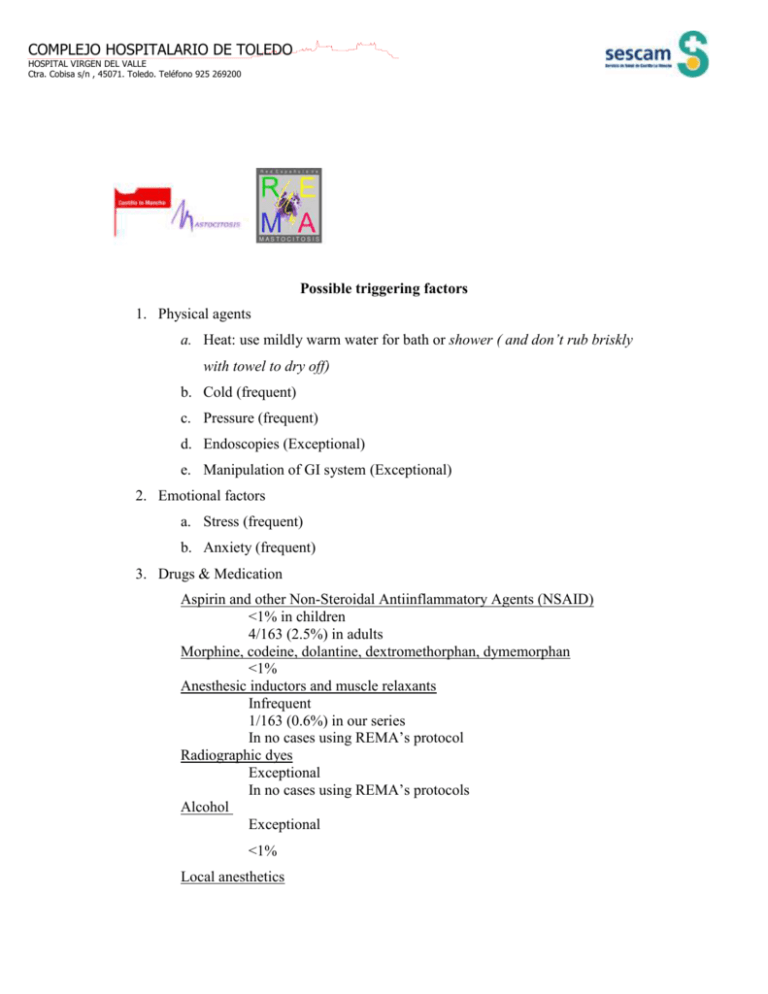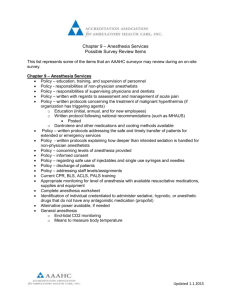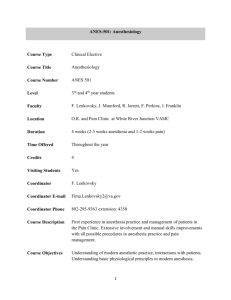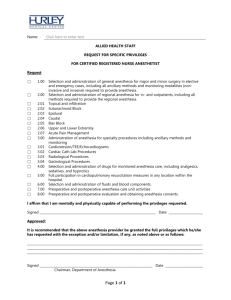different factors that stimulate the release of different factors from
advertisement

COMPLEJO HOSPITALARIO DE TOLEDO 1 HOSPITAL VIRGEN DEL VALLE Ctra. Cobisa s/n , 45071. Toledo. Teléfono 925 269200 Possible triggering factors 1. Physical agents a. Heat: use mildly warm water for bath or shower ( and don’t rub briskly with towel to dry off) b. Cold (frequent) c. Pressure (frequent) d. Endoscopies (Exceptional) e. Manipulation of GI system (Exceptional) 2. Emotional factors a. Stress (frequent) b. Anxiety (frequent) 3. Drugs & Medication Aspirin and other Non-Steroidal Antiinflammatory Agents (NSAID) <1% in children 4/163 (2.5%) in adults Morphine, codeine, dolantine, dextromethorphan, dymemorphan <1% Anesthesic inductors and muscle relaxants Infrequent 1/163 (0.6%) in our series In no cases using REMA’s protocol Radiographic dyes Exceptional In no cases using REMA’s protocols Alcohol Exceptional <1% Local anesthetics 2 Exceptional using amide-derivatives Interferon alpha 2b Exceptional In no cases using REMA’s protocols Clorodeoxiadenosine (Cladribine or 2-Cda) Exceptional (J. Sheik, Beth Israel Hospital, Harvard Medical School, personal communication, September 2002) 4. Others a. Molecules with high molecular weight used in cases of hypotension or or hypovolemia SPECIFIC PROTOCOLS THAT SHOULD BE USED IN PATIENTS WITH MASTOCYTOSIS The protocol mentioned below, is directed to patients with all type of mastocytosis. The following protocol has been put together by Dr. Maria Luisa Gutierrez Benavides (Anesthesia Department), and Luis Escribano Mora (Hematology Department). GENERAL PREPARATION 1. Corticosteroids (i.e. prednisone) 50 mg 8 hours, and 1 hour before the anesthesia (optional) 2. Chlorpheniramine maleate: 5 mg IV one hour before the anesthesia 3. Ranitidine: 100 mg diluted in 50 mls of saline IV one hour before anesthesia 4. Singulair: 1 tablet of 10 mg 24 hours before, and another one 1 hour before anesthesia (Mariana Castells, Brigham and Women’s Hospital, Harvard Medical School, personal communication, September 2003) 3 PRE-MEDICATION 1. Relaxation is important to avoid anxiety. Valium and other drugs can be used without any problem INDUCTION 1. Etomidate: dosage: 0.3 mg/kg of weight MUSCLE RELAXANTS 1. Vercuronium: dosage 0.1 mg/kg of weight. There are not data about the safety of other muscle relaxants such as pancuronium, cis.atracurium, among others. FOLLOW UP 1. Inhalants of the “flurane” family (sevoflurane). They will be used in enough concentration to keep a deep anesthesia. OTHER CONSIDERATIONS 1. The morphine and all the derivatives must be excluded as anesthetics in mastocytosis patients. There is not safety data about remifentanil hydrochloride in mastocytosis. 2. The colloids can induce anaphylactic reaction in mastocytosis and must not be used in or outside anesthesia 3. Diazepam (Valium) can be used without problems 4. Do not use beta-adrenergic blockers or alpha-adrenergics. Do not use antagonists of cholinergic receptors. 5. Determine the serum levels of tryptase before, during and after surgery TREATMENT OF EPISODES OF ACUTE RELEASE OF MEDIATORS DURING ANESTHESIA 1. Anaphylactic shock: Epinephrine, hydrocortisone, antihistamines H1 and H2 blockers 2. Severe hypotension: IV Fluid therapy (not colloids such as Dextran), Epinephrine, Dopamine, Dobutamine hydrochloride. 3. Severe Hemorrhage: Treatment following anomalies detected in coagulation studies. Think about the possibility of hyperfibrinolisis (dysfunction in clotting mechanism). 4 PROTOCOL OF LOCAL ANESTHESIA IN PATIENTS WITH MASTOCYTOSIS The techniques of local anesthesia must be considered as optional procedures for patients, therefore, they must be used instead of general anesthesia when feasible. Use of premedication (see above) can be useful to avoid mast cell-mediator release induced by stress. (oral premedication sholud be used for skin or other tissue biopsies, dentristry, among others.) The rules that are mentioned below, are applicable to all types of local anesthesia: including cutaneous biopsy and an epidural anesthesia, among others. 1. If there is any indication of allergic reactions or the patient has never received local anesthesia, the protocol used for general anesthesia will be applied 2. Amide derivatives such as bupivacaine, lidocaine or mepivacaine must be used in this procedure. The local anesthetics that contain the ester group such as procaine, chloroprocaine, tetracaine/pontocaine, and benzacaine are contraindicated. RADIOLOGIC EXAMS WITH CONTRAST OR ANY OTHER RISK PROCEDURES Research studies and experience have shown that for the most part, x-ray exams using contrast can induce the release of mediators from mast cells. Therefore, and when possible, these type of exams should be avoided. If it was necessary their use, low molecular weight contrast must be chosen, these include ioxaglate (Hexabrix), iopromide (Ultravist) and iotrol, to avoid mast cell degranulation. In these cases, the patients will receive the same premedication as specified for general anesthesia: 1. Prednisone 50 mg at 8 hours and 1 hour before the anesthesia (optional) 2. Chorpheniramine maleate: 5 mg IV one hour before the anesthesia 3. Ranitidine: 100 mg diluted in 50 mls of saline IV one hour before anesthesia 4. Singulair: 1 pill of 10 mg 24 hours and another one 1 hour before anesthesia 5 The procedure will be carried out under strict supervision. PROCEDURE TO FOLLOW IN CASE OF AN ANAPHYLACTIC SHOCK AFTER A MOSQUITOS, BEES OR WASPS BITES 1. In adults Epinephrine at 1:1000 concentration, 0.3 to 0.5 ml will be injected right away (Using an Epi-pen or Twin-ject). For this situation, all family members must be trained. In local reactions or in systemic reactions without vascular collapse antihistamine H1 (i.e. chlorpheniramine maleate 6 mg oral) and H2 (ratinidine/Zantac 300 mg oral) should be used in combination with prednisone (mg/kg) 2. In kids, if they need to use adrenaline, it must be given according to the weight 3. The patient should go to a hospital Centro de Estudios de Mastocitosis de Castilla a Mancha (CLMast) Hospital Virgen del Valle Red Española de Mastocitosis (REMA) Carretera de Cobisa s/n Toledo E-45071, Spain Contacts: Iván Álvarez-Twose, MD E: ivana@sescam.jccm.es Luis Escribano, MD, PhD E: lescribanom@sescam.jccm.es Laura Sánchez Muñoz E: lsmunoz@sescam.jccm.es Isabel Sánchez Matas E: imsanchez@sescam.jccm.es Phone: Dr. Escribano +34-925269335 Dr. Alvarez +34-925269336 Urgencias 24 horas: +34-638226196 Dr. Escribano: 638226228 Enfermería: +34925265407 Secretaría: +34-925269334 Consulta y urgencias: consultaclmast.cht@sescam.jccm.es Secretaría secretariaclmast.cht@sescam.jccm.es





